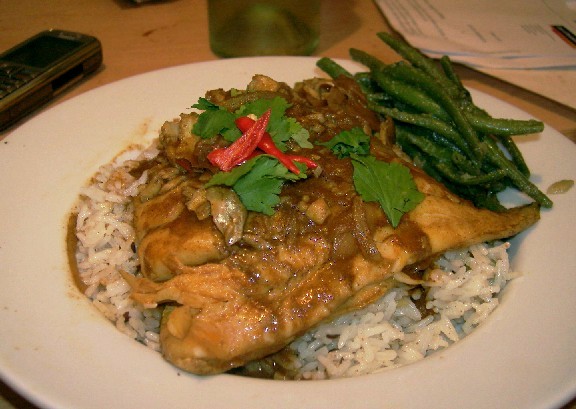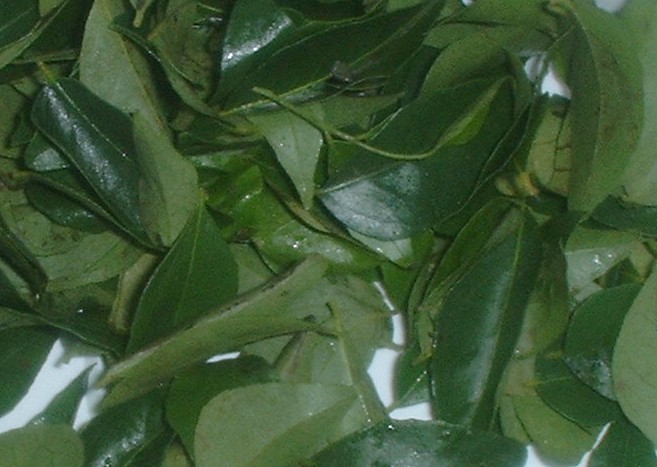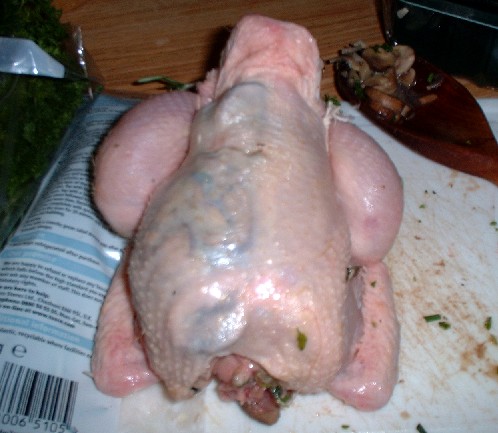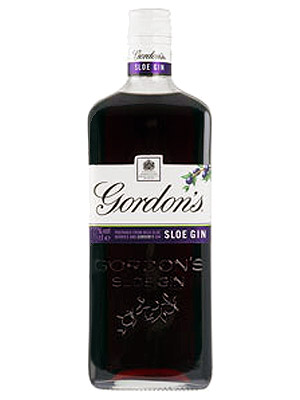
This will be my entry for this week’s weekend herb blogging, so I imagine a lot of you coming through from our lovely host’s site may want to see the photo …..

and skip to the end for the recipe. 
Some others among you may notice something a bit odd about that picture. I’m sure you know that food bloggers generally take great care with their photography. Hell, Amanda and Tyler even have their own photo tent with special lighting! Whilst I haven’t got that much equipment (yet), I still do my best for the blog. So why then do I have a fairly scruffy photo with my mobile phone, Goon’s course notes and several other pieces of rubbish in the background for this dish?
It’s all down to one of Goon’s flatmate. Once upon a time, when I was a sprightly second year student, I thought there was no way I’d ever want to live on my own. My flatmates were great, I adored spending time with them and arguments were rare. How things have changed! Spending time at Goon’s in the presence of his cohabitants is starting to turn me into a bit of a misanthropic cow.
Let’s face it,when you’re a foodie, it is damn hard sharing a kitchen with people who think a good meal (as in one they would cook for a formal dinner party) is Tesco value tuna, tomato sauce and pasta.
Then we have the case of disappearing food. It appears the irritating squeamish one has another bad habit: throwing out food that looks even remotely unfamilar or has any kind of aroma. We have lost a dragonfruit “because it looked funny” and the best part of a pheasant “because it smelt funny” and a fresh pack of smoked salmon “because it smelt of fish.”
What the hell did she think salmon should smell like!? Rose petals?
A more pressing irritation is that, recently, one flatmate has taken to having Bible parties in the front room. Yes, you read it correctly. BIBLE parties. This means that the room has to be immaculate and we certainly can’t eat in there, which is a right pain because that is where the dining table is. Goon and I are forced to eat in his rather cramped bedroom on the very full computer table.
It is annoying to be kicked out of the dining room when setting the table, but the conversations going on between this lot are plain disturbing. This lot have a book that lists all the words in the Bible alphabetically and gives page references for each. They LOVE that thing.
“Oooh, look it says the word ‘and’ appears 5,907 times in the Bible.”
“Really? I wonder whether these numbers have any significance.”
“How many times does the work ’the’ appear?”
Crazy!
I hate eating diiner in the bedroom. Rice gets on the floor and the lack of space means it is so much harder to photograph in there and we end up with clutter in the background. Also, Goon has a habit of hiding the plates under the bed so he can avoid the washing up. For days you wonder what the funny smell is, and then a couple of weeks later you find the plates, by then fully concious and with their own legs, making a daring escape out of the bedroom window.
Ok, maybe I made the last bit up, but they do end up covered in an interesting range of several species of mould. Goon’s bedroom is a mycologist’s dream.
Now that I’ve had my rant and explained the reason for the dodgy photo, here’s the interesting bit: a rough recipe for the Goan fish curry. This will work for most fish, although I prefer to use something white and flakey, like cod or haddock. This dish is easy to make and really tasty.
Take a large onion, peel it and slice it into thin half-rings. Fry it gently in groundnut oil with a lot (about 1 tablespoon each) of coriander and cumin, a large clove of crushed garlic and about the same amount of ginger, two chopped red birds eye chillies, a teaspoon of cayenne, two teaspoons of paprika and a teaspoon of turmeric. When the onions are soft, add about 100ml of fish stock and about 150ml of coconut milk, and allow the lot to bubble until you have a slightly thin curry sauce.
At this point I add the ingredient that really makes a goan curry: tamarind. I generally use tamarind paste which I get from Asian speciality stores. I find the trick to using tamarind paste is to dilute it with a little bit of water and then add it slowly to the dish , tasting every so often to make sure you aren’t overdoing it. Tamarind is one of those things that can make a dish delicious but, a little too much makes it sour and, to some people, unpalatable, so it pays to be careful.
After adding your desired amount of tamarind, add the fish fillets to the sauce and simmer for amout ten minutes until they are cooked. Then taste, adjust spice and seasoning and serve over basmati rice (perhaps flavoured with ginger and spring oniions) with a vegetable curry. Last night we had beans with coriander and garlic, cooked in coconut milk.
This is a really delicious dish. The tamarind provides a pleasant sour pungency that is followed by a slight sweetness from the coconut milk and a warmth from the spice. Personally I might add another chilli, but Goon gets funny about these things.
It is the tamarind in this dish that makes it suitable to be an entry to Kalyn’s Weekend Herb Blogging which this week is hosted by Becky from Key Lime and Coconut.
For those of you unfamiliar with tamarind, the spice is the fruit pulp of a tree native to East Africa. It now is found all over Asia and South America as well. The young fruits of this tree have the sour flavour that makes a Goan curry so special. As the fruits get older they become sweeter and then are more suitable for use in desserts.
Ifyou may think you’ve never had tamarind, you may be suprised. It is one of the main ingredients in Worcestershire sauce!
So there we go- a rant, a recipe and a brief collection of facts on a very tasty spice. Never let it be said that this blog lacks variety. 
This will be my entry for this week’s weekend herb blogging, so I imagine a lot of you coming through from our lovely host’s site may want to see the photo …..
and skip to the end for the recipe. ![]()
Some others among you may notice something a bit odd about that picture. I’m sure you know that food bloggers generally take great care with their photography. Hell, Amanda and Tyler even have their own photo tent with special lighting! Whilst I haven’t got that much equipment (yet), I still do my best for the blog. So why then do I have a fairly scruffy photo with my mobile phone, Goon’s course notes and several other pieces of rubbish in the background for this dish?
It’s all down to one of Goon’s flatmate. Once upon a time, when I was a sprightly second year student, I thought there was no way I’d ever want to live on my own. My flatmates were great, I adored spending time with them and arguments were rare. How things have changed! Spending time at Goon’s in the presence of his cohabitants is starting to turn me into a bit of a misanthropic cow.
Let’s face it,when you’re a foodie, it is damn hard sharing a kitchen with people who think a good meal (as in one they would cook for a formal dinner party) is Tesco value tuna, tomato sauce and pasta.
Then we have the case of disappearing food. It appears the irritating squeamish one has another bad habit: throwing out food that looks even remotely unfamilar or has any kind of aroma. We have lost a dragonfruit “because it looked funny” and the best part of a pheasant “because it smelt funny” and a fresh pack of smoked salmon “because it smelt of fish.”
What the hell did she think salmon should smell like!? Rose petals?
A more pressing irritation is that, recently, one flatmate has taken to having Bible parties in the front room. Yes, you read it correctly. BIBLE parties. This means that the room has to be immaculate and we certainly can’t eat in there, which is a right pain because that is where the dining table is. Goon and I are forced to eat in his rather cramped bedroom on the very full computer table.
It is annoying to be kicked out of the dining room when setting the table, but the conversations going on between this lot are plain disturbing. This lot have a book that lists all the words in the Bible alphabetically and gives page references for each. They LOVE that thing.
“Oooh, look it says the word ‘and’ appears 5,907 times in the Bible.”
“Really? I wonder whether these numbers have any significance.”
“How many times does the work ’the’ appear?”
Crazy!
I hate eating diiner in the bedroom. Rice gets on the floor and the lack of space means it is so much harder to photograph in there and we end up with clutter in the background. Also, Goon has a habit of hiding the plates under the bed so he can avoid the washing up. For days you wonder what the funny smell is, and then a couple of weeks later you find the plates, by then fully concious and with their own legs, making a daring escape out of the bedroom window.
Ok, maybe I made the last bit up, but they do end up covered in an interesting range of several species of mould. Goon’s bedroom is a mycologist’s dream.
Now that I’ve had my rant and explained the reason for the dodgy photo, here’s the interesting bit: a rough recipe for the Goan fish curry. This will work for most fish, although I prefer to use something white and flakey, like cod or haddock. This dish is easy to make and really tasty.
Take a large onion, peel it and slice it into thin half-rings. Fry it gently in groundnut oil with a lot (about 1 tablespoon each) of coriander and cumin, a large clove of crushed garlic and about the same amount of ginger, two chopped red birds eye chillies, a teaspoon of cayenne, two teaspoons of paprika and a teaspoon of turmeric. When the onions are soft, add about 100ml of fish stock and about 150ml of coconut milk, and allow the lot to bubble until you have a slightly thin curry sauce.
At this point I add the ingredient that really makes a goan curry: tamarind. I generally use tamarind paste which I get from Asian speciality stores. I find the trick to using tamarind paste is to dilute it with a little bit of water and then add it slowly to the dish , tasting every so often to make sure you aren’t overdoing it. Tamarind is one of those things that can make a dish delicious but, a little too much makes it sour and, to some people, unpalatable, so it pays to be careful.
After adding your desired amount of tamarind, add the fish fillets to the sauce and simmer for amout ten minutes until they are cooked. Then taste, adjust spice and seasoning and serve over basmati rice (perhaps flavoured with ginger and spring oniions) with a vegetable curry. Last night we had beans with coriander and garlic, cooked in coconut milk.
This is a really delicious dish. The tamarind provides a pleasant sour pungency that is followed by a slight sweetness from the coconut milk and a warmth from the spice. Personally I might add another chilli, but Goon gets funny about these things.
It is the tamarind in this dish that makes it suitable to be an entry to Kalyn’s Weekend Herb Blogging which this week is hosted by Becky from Key Lime and Coconut.
For those of you unfamiliar with tamarind, the spice is the fruit pulp of a tree native to East Africa. It now is found all over Asia and South America as well. The young fruits of this tree have the sour flavour that makes a Goan curry so special. As the fruits get older they become sweeter and then are more suitable for use in desserts.
Ifyou may think you’ve never had tamarind, you may be suprised. It is one of the main ingredients in Worcestershire sauce!
So there we go- a rant, a recipe and a brief collection of facts on a very tasty spice. Never let it be said that this blog lacks variety. ![]()





